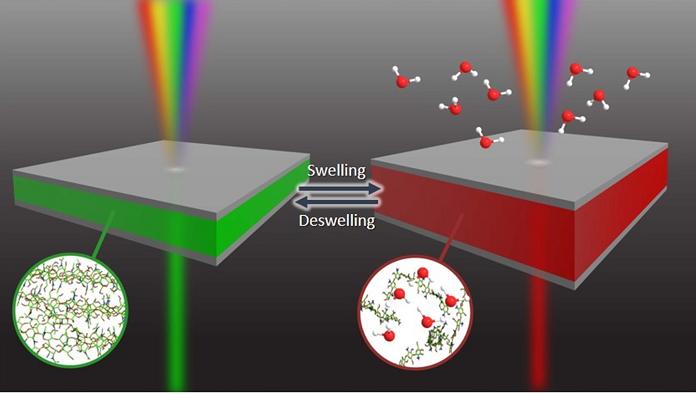Smart windows that self-illuminate on rainy days

Metal-hydrogel-metal filter structure that repeats expansion and contraction as moisture level changes around it. Credit: Junsuk Rho (POSTECH)
Recently, a Korean research team has developed the source technology for smart windows that change colors according to the amount of moisture, without needing electricity.
The joint research team comprised of Professor Junsuk Rho of departments of mechanical and chemical engineering, Jaehyuck Jang and Aizhan Ismukhanova of chemical engineering department at POSTECH, and Professor Inkyu Park of KAIST's department of mechanical engineering.
Together, they successfully developed a variable color filter using a metal-hydrogel-metal resonator structure using chitosan-based hydrogel, and combined it with solar cells to make a self-powering humidity sensor. These research findings were published as a cover story in the latest edition of Advanced Optical Materials, a journal specializing in nanoscience and optics.
Sensors using light are already widely used in our daily lives in measuring the ECG, air quality, or distance. The basic principle is to use light to detect changes in the surroundings and to convert them into digital signals.
Fabri-Pero interference* is one of the resonance phenomena that can be applied in optical sensors and can be materialized in the form of multilayer thin films of metal-dielectric-metal. It is known that the resonance wavelength of transmitted light can be controlled according to the thickness and refractive index of the dielectric layer.
However, the existing metal-dielectric-metal resonators had a big disadvantage in not being able to control the wavelengths of transmitted light once they are manufactured, making it difficult to use them in variable sensors.
The research team found that when the chitosan hydrogel is made into the metal-hydrogel-metal structure, the resonance wavelength of light transmitted changes in real time depending on the humidity of the environment. This is because the chitosan hydrogel repeats expansion and contraction as the humidity changes around it.
Using this mechanism, the team developed a humidity sensor that can convert light's energy into electricity by combining a solar battery with a water variable wavelength filter made of metal-hydrogel-metal structured metamterial that changes resonance wavelength depending on the external humidity.
The design principle is to overlap the filter's resonance wavelength with the wavelength where the absorption of the solar cells changes rapidly. This filter is designed to change the amount of light absorption of solar cells depending on the amount of moisture, and to lead to electric changes that ultimately detect the surrounding humidity.
Unlike the conventional optical humidity sensors, these newly developed ones work regardless of the type of light, whether it be natural, LED or indoor. Also, not only does it function without external power, but it can also predict humidity according to the filter's color.
Professor Junsuk Rho who led the research commented, “This technology is a sensing technology that can be used in places like nuclear power reactors where people and electricity cannot reach.” He added, “It will create even greater synergy if combined with IoT technology such as humidity sensors that activate or smart windows that change colors according to the level of external humidity.”
###
The study was supported by the Samsung Research Funding & Incubation Center for Future Technology.
Media Contact
Jinyoung Huh
jyhuh@postech.ac.kr
82-542-792-415
Media Contact
All latest news from the category: Power and Electrical Engineering
This topic covers issues related to energy generation, conversion, transportation and consumption and how the industry is addressing the challenge of energy efficiency in general.
innovations-report provides in-depth and informative reports and articles on subjects ranging from wind energy, fuel cell technology, solar energy, geothermal energy, petroleum, gas, nuclear engineering, alternative energy and energy efficiency to fusion, hydrogen and superconductor technologies.
Newest articles

Scientists transform blood into regenerative materials
… paving the way for personalized, blood-based, 3D-printed implants. Scientists have created a new ‘biocooperative’ material based on blood, which has shown to successfully repair bones, paving the way for…

A new experimental infection model in flies
…offers a fast and cost-effective way to test drugs. Researchers at the Germans Trias i Pujol Research Institute and Hospital have reinforced their leading role in infectious disease research by…

Material developed with novel stretching properties
KIT researchers produce metamaterial with different extension and compression properties than conventional materials. With this material, the working group headed by Professor Martin Wegener at KIT’s Institute of Applied Physics…



